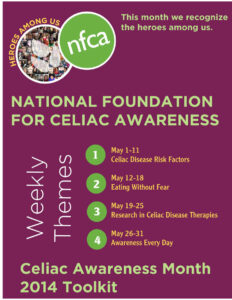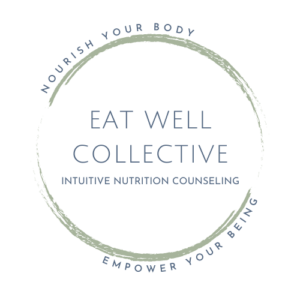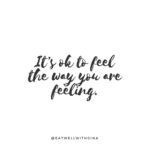 May is Celiac Awareness Month and while many people choose gluten-free foods as a lifestyle choice, they may not understand the seriousness of celiac disease. An estimated 3 million people in the United States have celiac disease – that’s 1 in 133 people; and only 10% of them have been diagnosed.
May is Celiac Awareness Month and while many people choose gluten-free foods as a lifestyle choice, they may not understand the seriousness of celiac disease. An estimated 3 million people in the United States have celiac disease – that’s 1 in 133 people; and only 10% of them have been diagnosed.
Celiac disease is an autoimmune digestive disease that damages the villi (small hair-like projections) in the small intestine. This damage means that the small intestine does not do a good job of absorbing nutrients from food. When a person with celiac disease consumes gluten, a protein found in wheat, rye and barley, their immune system responds by attacking the small intestine and inhibiting the absorption of important nutrients into the body.
Some people develop celiac disease as children, others as adults, but generally celiac disease affects people differently. There are over 300 hundred signs and symptoms of celiac disease, many of them subtle and seemingly unrelated. Yet many people with celiac disease have no symptoms at all. In those cases, the undamaged part of their small intestine is able to absorb enough nutrients to prevent symptoms. However, people without symptoms are still at risk for some of the complications of celiac disease such as osteoporosis, infertility, neurological conditions and, in rare cases, cancer.
Common symptoms of celiac disease may include one or more of the following:
- Frequent abdominal bloating and pain
- Chronic diarrhea or constipation
- Fatigue
- Vomiting
- Weight loss
- Pale, foul-smelling stool
- Delayed puberty
- Iron-deficiency anemia that does not respond to iron therapy
- Failure to thrive or short stature
- Pain in the joints
- Tingling numbness in the legs
- Pale sores inside the mouth
- Peripheral neuropathy
- A skin rash called dermatitis herpetiformis (DH)
- Tooth discoloration or loss of enamel
- Unexplained infertility or recurrent miscarriage
- Osteopenia (mild) or osteoporosis (more serious bone density problem)
- Psychiatric disorders such as anxiety or depression
No matter what a person’s symptoms are or when they are diagnosed, the only treatment for celiac disease is to follow a gluten-free diet by avoiding all foods that contain gluten for the rest of their life. For most people, following this diet will stop symptoms, heal existing intestinal damage and prevent further damage. Eating any gluten-containing food, no matter how small an amount, can damage the intestine. This is true for anyone with the disease, including people who do not have noticeable symptoms.
There are many healthy gluten-free alternatives available. Several whole grains are naturally gluten-free, including quinoa, buckwheat, amaranth, brown rice, millet, sorghum and teff.
Other healthy gluten-free ingredients to look for are almond meal, coconut flour, pea flour, soy flour, potatoes and corn. While oats do not contain gluten, they are often processed in facilities that also process wheat and can be contaminated with gluten. To avoid any potential reaction choose products made with “certified gluten-free” oats.
The market for gluten-free products grew 44% between 2011 and 2013, and is projected to continue to rise, reaching sales of $15.6 billion by 2016.
As I mentioned earlier, many people choose gluten-free foods as a lifestyle choice. Many people who decide to jump on the gluten-free bandwagon do so blindly and may not even know what gluten is or why they are even avoiding it. A gluten-free diet was never intended to be the latest “diet fad”.
Recently on “Jimmy Kimmel Live” the comedian, Jimmy Kimmel, said that he suspected that some people shun gluten in their diet simply because somebody told them. Below you will find his “Ask the Pedestrian” segment where pedestrians were gluten-free individuals were asked what gluten is. While there are many people who know what gluten is, there are also people who need to educate themselves before making changes to their diet.
Working with a Registered Dietitian can be extremely helpful. A Registered Dietitian, like myself, can help a person who has been diagnosed with celiac disease to:
- ensure adequate intake of essential nutrients iron, calcium, fiber, and B-vitamins
- understand which foods are safe to eat and which to avoid
- assist with meal planning for eating at home and for eating out
- avoid unwanted weight gain as a result of increased nutrient and calorie absorption from food once the digestive tract begins to heal
 The National Foundation for Celiac Awareness has published a Celiac Awareness Month Toolkit that provides facts, figures and tools to help you play your part. It is simple to download.
The National Foundation for Celiac Awareness has published a Celiac Awareness Month Toolkit that provides facts, figures and tools to help you play your part. It is simple to download.
In it, you’ll find:
- Special events they are hosting throughout the month, including Twitter chats and webinars
- Facts about celiac disease, non-celiac gluten sensitivity, and the gluten-free diet
- Celiac disease risk factors and the importance of and tips for getting tested
- Tips for dining out
- The latest in research for celiac disease therapies
- Recipes
- Tips for how YOU can help to spread awareness
Here are some other great resources:
The National Foundation for Celiac Awareness (NFCA) — many excellent Printable Guides, including the brand new Getting Started Guide, which is a comprehensive 48-page guide to everything you need to know!
GlutenFreeTravelSite — thousands of user-submitted reviews of restaurants, cruises, colleges, and more. You can easily search online or download the free app called Dine Gluten Free.
Gluten-Free Drugs — a reliable list of prescription or OTC gluten-free drugs that is continually updated by a clinical pharmacist.
Celiac Listserv — a place to get answers when you have a question about celiac disease or gluten-free life.
Celiac Disease Awareness Campaign — educational materials and resources as well as info on the latest research and clinical trials.
American Celiac Society — an organization that supports efforts in education, research, and mutual support to individuals with dietary disorders. It helps set up support groups, sponsors conferences, seeks funding for education and research, identifies ingredients in foods and food supplements, and educates the public about problems facing its members.
Celiac Disease Foundation — drives early diagnosis and treatment of celiac disease through advocacy, education and advancing research to improve the quality of life for all people affected by gluten-related disorders. Check out their 7 day gluten-free meal plan.
Celiac Support Association — is the major non-profit supporting those with celiac disease and related disorders throughout America with chapters, resource units and members across the country.
Do you have Celiac Disease?
If so, what were your symptoms and how were you diagnosed?
I would love to hear from you!



